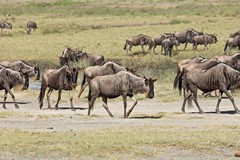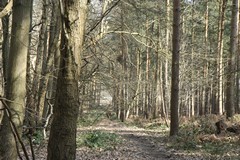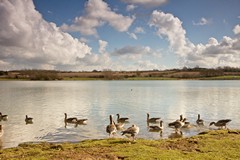Different light sources produce ‘white’ light with slightly different colour tints, depending on the 'temperature' of the light, but our brains can correct for these variations, so we don’t see a change in colour when we move from a garden lit by sunlight, to a shady wood, or into a room lit by artificial light. A cloudy day will also produce different white light to a sunny day.

Roll your mouse over this photo. The rollover
has had its white balance adjusted in post
production. By increasing the temperature
from 5550 K (original as shot) to 7500 K
(deep shade) it has effectively warmed up
the scene. I've overdone it a bit to
illustrate the effect
White balance (WB) corrects the light for colour casts, so that objects which appear white in your eye are rendered white in your photo. Camera white balance has to take into account the colour temperature of a light source, which refers to the relative apparent warmth or coolness of light.
Colour temperature is conventionally stated in the unit of absolute temperature, the Kelvin, with the unit symbol K.
Colour temperatures over 5,000K are called cool colors (bluish white), while lower color temperatures (2,700–3,000 K) are called warm colors (yellowish white to red).
This at at odds with physical measurements as Red light is cooler than Blue light in terms of heat, but that's the way we humans perceive it.
Very Approximate Colour Temperatures

Roll your mouse over this photo. These two
shots were taken straight after each other.
The first was at a sunny White Balance
setting of 5250 K and the second was a much
cooler looking 4300 K. When comparing them
with the actual colours on the spot the
lower temperature gave the best
approximation
Cameras can happily be left on an Auto White Balance setting for a great deal of the time. But you should check on the camera display to see that the colours you are getting match the colours that you are seeing. The wrong White balance will result in odd colour tints in your photos and these can be quite severe depending on the difference between the actual colour temperature and that which the camera has decided on, and in that case you will need to select a white balance manually.
To set the white balance you can either pick the appropriate setting from the list of symbols that will be shown in your camera, or on some models you can dial in the exact temperature that you would like to set it at. You can then take a shot and compare the colours on the camera screen with those you are observing, and adjust accordingly.
You can deliberately 'warm up' or 'cool off' the look of your photos by changing the white balance manually before taking the shot. For instance, setting the temperature to around 6500 K (cloudy WB) on a sunny day (5400K) will have the effect of adding extra warmth to the picture. Setting it to 4200k will make it look cooler
To control WB exactly, you can use the Custom or Manual white balance option and set the value manually.
Your camera’s manual will explain exactly how to do this, but basically it involves photographing a white or neutral grey target, such as a piece of card, in the same light as your subject and then telling your camera to use this image to set the white point and use it to calculate the correct colours in the photo.

Roll your mouse over this photo. This
Winter scene looks better to me with a
cooler white balance setting. However, the
final say is up to you, especially if you
shoot in RAW and can play with the WB as
much as you like with no damage to the
original file
Also when using a flash at a temperature of around 5400 K in a room lit by Incandescent bulbs at around 3500 K, you can get odd colour casts that just don't look right. One solution here would be to balance the flash temperature to that of the light bulbs by putting a pale orange filter over the flash. There are many books written about flash photography and my advice is to read one or two as it's a whole new branch of the hobby which can make some spectacular differences to your photos.
Whether you shoot in RAW or JPG you have the ability to adjust the white balance in Photoshop or many other image editor, and so getting it right is not critical, but it can use up a lot of time correcting a whole batch of images.
Images can often take on a colour cast in natural light as well ie. too green or too red, and image editing software also has the ability to adjust these colour inaccuracies in post production, generally linked to the white balance editing tool.